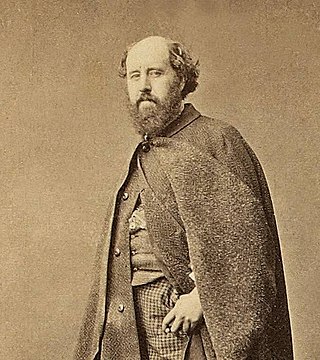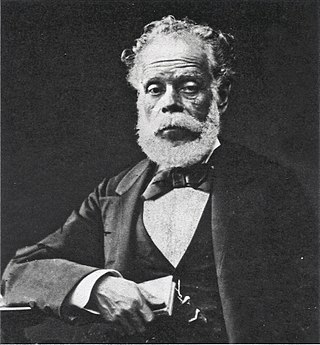
Surquillo is a district located in Lima, Peru. The district is bordered by the districts of San Isidro and San Borja on the north; by Miraflores on the south and west; and by Santiago de Surco on the east.

The Historic Centre of Lima is the historic city centre of the city of Lima, the capital of Peru. Located in the city's districts of Lima and Rímac, both in the Rímac Valley, it consists of two areas: the first is the Monumental Zone established by the Peruvian government in 1972, and the second one—contained within the first one—is the World Heritage Site established by UNESCO in 1988, whose buildings are marked with the organisation's black-and-white shield.

Ignacio Merino Muñoz was a Peruvian painter notable for historical and costumbrista works, and considered the founder of the Peruvian school of painting. Beginning at age 6, he spent much of his life in Paris.

The Plaza San Martín is one of the most representative public spaces of the city of Lima, Peru. It is located at the ninth block of Colmena avenue, within the Historic Centre of Lima which was declared a World Heritage Site in 1988 by UNESCO. It is located near the Plaza Mayor of Lima and is connected to it by the Jiron de la Union. Its central monument gives homage to Peru's liberator, José de San Martín.

The Dos de Mayo Square, known as the Óvalo de la Reina until 1866, is a public square located in Lima, Peru. Located on the southwestern edge of the historic centre's bufferzone, it serves as the junction of several important avenues, including Alfonso Ugarte, La Colmena and Colonial avenues. In the late 20th century, a vehicular tunnel was built under the square to curb traffic congestions.

The Municipal Theatre of Lima, inaugurated as the Teatro Forero, is a theatre and concert hall in the historic centre of Lima, Peru. It is home to the country's National Symphony Orchestra.

Francisco Fierro Palas, called "Pancho" Fierro, was a Peruvian painter, known primarily for his costumbrista watercolors, which depict his country's life and customs.
Bernardo Rivero Arenazas was born in 1889 in Callao, Peru and died in Lima in 1965. He is considered one of the greatest Peruvian painters of the early 20th century and one of the pioneers of Peruvian painting. The Law and Political Science Faculty of the Universidad de San Martín de Porres includes Rivero as part of the great masters of the Peruvian painted art and states that between 1890 and 1935 a generation of painters was born, distinguished for their great versatility in the aesthetic field.

The Park of Legends, formally the Dr. Felipe Benavides Barreda Park of Legends, is a zoo located in San Miguel District, Lima, Peru. It is managed by the Metropolitan Municipality of Lima (MML). It is the most influential and visited zoo in the entire capital, featuring recreation and entertainment areas, archaeological museums, a botanical garden, among other facilities.
Johanna Hamann Mazuré was a Peruvian sculptor. She emerged as a contemporary artist in the early 1980s and she is known for her sculptures that explore and represent the human body through unconventional perspectives.

Jorge Vicente Martín Muñoz Wells is a Peruvian lawyer and politician who served as mayor of Lima from January 2019 until his removal from office by the National Jury of Elections in April 2022. He previously served as mayor of Miraflores from 2011 to 2018.

The Statue of Liberty is a bronze sculpture located in the Plaza Francia of the historic centre of Lima, Peru. It was made in 1926 according to the design of the French sculptor René Bertrand-Boutée and cast by Eugène Soleau. It is a one-piece bronze sculpture about 2 metres high and represents a standing female figure, dressed in a light tunic and with a laurel wreath on her head. This is installed on a 4.30 m high pedestal. The sculpture and the Plaza Francia were declared a monumental urban environment in 1972. In 2018, La Libertad was declared Cultural Heritage of the Nation.

Óscar Guillermo Allain Cottera is a Peruvian painter of French descent.

The Monumental Museum of the District Municipality of Huanta, also known simply as the Huaura Balcony, is a war museum located in the Peruvian city of Huaura, dedicated to the memory of José de San Martín and the Liberating Expedition of Peru. The museum is housed in a Viceregal house that originally belonged to the Royal Customs of Lima. It was declared a historical monument by Law No. 9636 of October 28, 1942.

Jirón Camaná is a major street in the Damero de Pizarro, located in the historic centre of Lima, Peru. The street starts at the Alameda Chabuca Granda and continues southwest until it reaches Jirón Jacinto López, next to the Plaza Francia, continuing directly south until it reaches Bolivia Avenue, next to the Lima Civic Center.

The Plaza de Francia, also known by its former name, Plazoleta de la Recoleta, is a public square in the historic centre of Lima, Peru.

Jirón Rufino Torrico, formerly known as Jirón Arica, is a major street in the Damero de Pizarro, located in the historic centre of Lima, Peru. The street starts before its intersection with the Jirón Conde de Superunda, parallel to the Prolongación Tacna, and continues until it reaches Inca Garcilaso de la Vega Avenue.
The Municipal Programme for the Recovery of the Historic Centre of Lima, also known by its acronym PROLIMA, is an organisation of the Peruvian government aimed at the recovery of the historic centre of Lima, both in its declared Cultural heritage of Peru status in 1972 and as a World Heritage Site of UNESCO in 1991.

María Graña Ottone Friendship Park is a public park located at the intersection of Alfredo Benavides and Caminos del Inca avenues, in Santiago de Surco, Lima, Peru. It features a monumental arch based on the one that once stood at Arequipa Avenue, in Lima District.



















